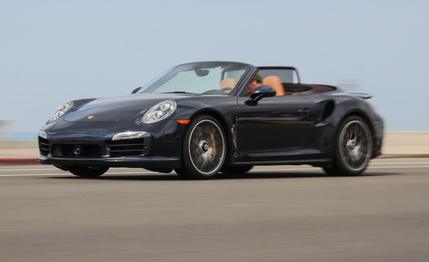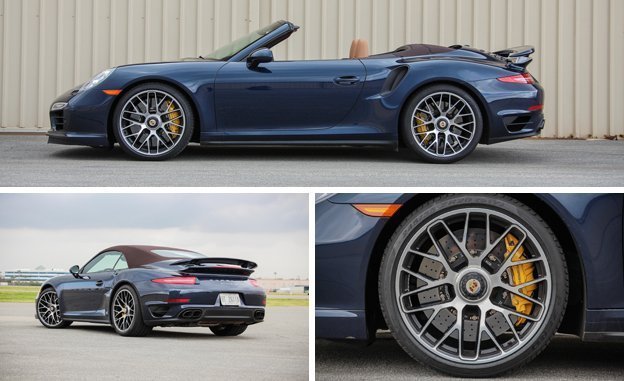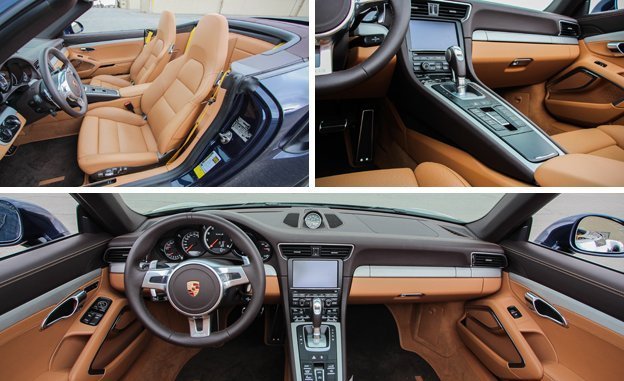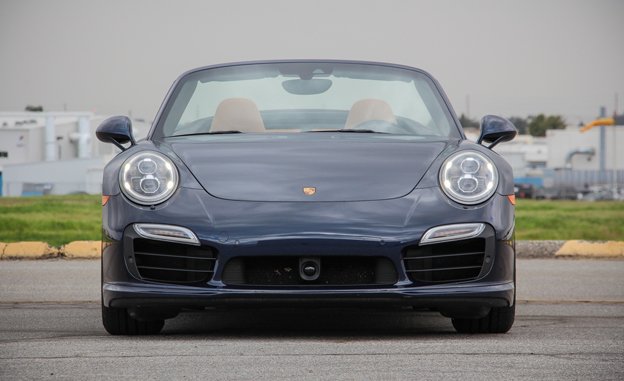
 Instrumented Test
Instrumented Test
Our old mental image of the Porsche 911 as that expensive but attainable little sports car for people willing to stretch just a bit from a Corvette has been outdated for several years now. First off, the 911 is no longer little, being half an inch longer than the hardly-small C7 Corvette. And its attainability, if it ever existed, seems a distant memory. Although you can order a stripper Carrera for $85,295, thanks to Porsche’s thick catalog of available options, it seems ages since we’ve seen one for less than $100K. And here we have the top-dog 911, the Turbo S Cabriolet, with a stunning price of $210,620, a figure that moves the 911 beyond its traditional phylum in the near-exotic and fully into the realm of boutique bolide.
Well, there’s no point in acting all surprised about it. As the Cayman/Boxster have increased in capability, the 911 has naturally moved up as well. By design, it has matured into a gran turismo available in many flavors and offering the kind of do-everything comfort and do-anything speed demanded by people who can afford its lofty price.
The forthcoming GT3 will, of course, be amazing, but it’ll be something of a poseur, the 911 having grown so girthy as to render a hyper track version rather tangential to the mission. We all know the slimmer, lighter Cayman GT4 is what serious folk want for track work. The GT3 will be for sporty types with deeper pockets but, in most cases, nominal ability to set quicker lap times.


So where does that leave the 560-hp Turbo S Cab? In the very thin atmosphere where the Aston Martin DB9 Volante and the Bentley Continental GT V8 S convertible reside. You have some choices up there depending on where lie your personal preferences for ride comfort and sound isolation. Though it is luxurious compared with other 911s, the all-wheel-drive Turbo S Cab sits at the sportier end of its price spectrum, even further than the Audi R8 Spyder, with some astonishing performance numbers and a fairly stiff ride even with the car in its comfort settings.
Launch control puts the computer in charge and sends the 3741-pound Turbo S Cab to the far side of 60 mph in just 2.8 seconds. A quarter-mile that nearly breaks into the 10s—11.1 seconds at 124 mph—attests to how serious this car gets when provoked. We saw 1.0 g on the skidpad and a stopping distance of 151 feet, both strong numbers abetted by the hilariously staggered Pirelli P Zeros (245/35 in front, 305/30 in back). Even so, the lighter Turbo S coupe is slightly quicker and sticks a little better, but you knew it would.
The Cab feels tightly wound and always ready to pounce, the standard carbon-ceramic brakes biting just a little too hard in city situations and the super-pressurized 3.8-liter flat-six supplying a digital, nothing-or-all response. That’s partly due to the one transmission available, the seven-speed PDK. Left in auto mode, it makes it tricky to summon just the right amount of thrust. Give the car too little throttle and not much happens, causing you to question the power ratings. Dip into it a little more and the transmission may drop two gears and unleash its full hydrocarbon hellfire. Lift and the boost blows off, the car slowing precipitously as if you’ve just driven into deep snow. Between the touchy brakes and the uncertain throttle, there’s a lot of back-and-forthing for the passengers, who voted the Turbo S the nicest vehicle in which to get reliably carsick.


Welcome to the exciting new world of Too Much Boost. Really, this car should have a bigger engine, as its competitors do. But this is a Porsche 911, and a smallish flat-six is a heritage trait if not a fuel-economy boon (as our 15-mpg average attests), so to make the big power, it has to be an off-on switch. This is also a preview of sports cars to come, as more and more manufacturers embrace smaller-displacement turbo engines that make big dyno numbers under hyper boost. In the 911, you can at least alleviate this problem partly by taking control of the transmission with the paddles, downshifting yourself when you want to go only a little quicker.
Porsche is serious about giving the softtop Cabrio the interior isolation of a hardtop. The headliner is actually solid, being several pieces of some type of sound-deadening material upholstered with black cloth. During the 13 seconds it takes the motors to stow the top, these pieces all collapse and accordion as necessary. Top up, the cabin is downright quiet at freeway speeds save for a slight wind ruffle around the windows. Once the top is down, a motorized screen can be raised to block out the licking wind.
Open to the world, the 911 really feels its size, like an immense Jacuzzi with a steering wheel. But this is one hot tub that hustles. Its cornering capabilities really exceed any challenge that most public roads can safely supply, the car stuck to the pavement as if it’s year-old tar. Given the engine’s location, you still get a little—but only a hint—of the bounding that 911s are famous for as the motor in its distant location levers the chassis over bumps and dips. With every 911 generation, Porsche continues to tame that demon.


Fast, precise steering puts the nose where you want it, though as in all current 911s it is isolated somewhat from the road. Again, this is intentional, Porsche figuring that 911 customers no longer want the steering wheel dancing in their hands over every pavement crack. That was the old days. One thing that is old school: the exhaust note, a delicious steel-lined riiiip punctuated by burp-bangs on the upshifts. Wonderful.
To reach its price, this Turbo S lays on a few options, the notable ones being the $3500 Burmester stereo, a $2490 safety package that includes adaptive cruise control, a $1710 “extended” leather option that wraps the dash in cowhide, incongruously yellow seatbelts for $540, and a leather fuse-box covers for $380. The key comes painted in the car’s dark-blue-metallic body color for $335. That’s just a partial list.
By building a 911 this expensive, Porsche moves the car from near-exotic to fully exotic, even if the valets at the supper club don’t treat it any better than the many Cayennes and Macans that routinely roll in. And therein lies a potential problem, for some with the means to spend this kind of money want other people to know it. And some just want a better ride in a more relaxed automobile. The Turbo S Cab is thus kind of a purist’s choice within its slim segment, and purists are always few in number.